- News
- Reviews
- Bikes
- Accessories
- Accessories - misc
- Computer mounts
- Bags
- Bar ends
- Bike bags & cases
- Bottle cages
- Bottles
- Cameras
- Car racks
- Child seats
- Computers
- Glasses
- GPS units
- Helmets
- Lights - front
- Lights - rear
- Lights - sets
- Locks
- Mirrors
- Mudguards
- Racks
- Pumps & CO2 inflators
- Puncture kits
- Reflectives
- Smart watches
- Stands and racks
- Trailers
- Clothing
- Components
- Bar tape & grips
- Bottom brackets
- Brake & gear cables
- Brake & STI levers
- Brake pads & spares
- Brakes
- Cassettes & freewheels
- Chains
- Chainsets & chainrings
- Derailleurs - front
- Derailleurs - rear
- Forks
- Gear levers & shifters
- Groupsets
- Handlebars & extensions
- Headsets
- Hubs
- Inner tubes
- Pedals
- Quick releases & skewers
- Saddles
- Seatposts
- Stems
- Wheels
- Tyres
- Health, fitness and nutrition
- Tools and workshop
- Miscellaneous
- Tubeless valves
- Buyers Guides
- Features
- Forum
- Recommends
- Podcast
review
£1,749.00
VERDICT:
Delivers an exciting and razor sharp ride that will reward any rider with the confidence to throw it around.
Weight:
7,009g
Contact:
www.airstreeem.com/en
At road.cc every product is thoroughly tested for as long as it takes to get a proper insight into how well it works. Our reviewers are experienced cyclists that we trust to be objective. While we strive to ensure that opinions expressed are backed up by facts, reviews are by their nature an informed opinion, not a definitive verdict. We don't intentionally try to break anything (except locks) but we do try to look for weak points in any design. The overall score is not just an average of the other scores: it reflects both a product's function and value – with value determined by how a product compares with items of similar spec, quality, and price.
What the road.cc scores meanGood scores are more common than bad, because fortunately good products are more common than bad.
- Exceptional
- Excellent
- Very Good
- Good
- Quite good
- Average
- Not so good
- Poor
- Bad
- Appalling
Airstreeem are a relatively new brand, having only been founded in 2008, hailing from Austria. The Aerotype is the company's aero frame with a dual position seat mast making it suitable for both road and time trial duties.
We took a full look at the features of the Airstreeem Aerotype in our first look a few weeks ago.
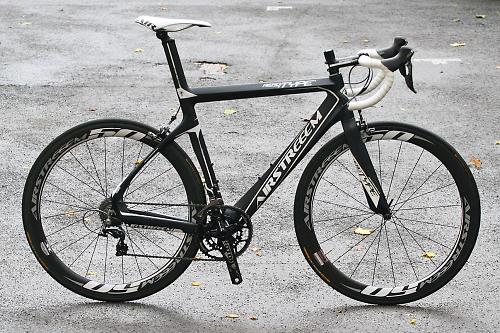
The first thing to note is that the frame sizes up quite small with a 'XL' size only coming with a 56cm top tube. This is because the bike is designed to be run with a time trial front end as well as a traditional road bike setup.
Typically, you'll want a shorter reach when using tri bars as you're effectively positioning your elbows where your hands usually are on drop bars. The reduced length means that most riders will have to run a longer stem than usual if using the Aerotype as a conventional road bike. I found myself having to use a 140mm stem to achieve my standard reach.

The steep 73.5 degree head angle and the relatively small trail results in a bike that handles very quickly. Even at higher speeds, the Aerotype retained a degree of responsiveness which is unusual for a bike designed with time trialling in mind.
In my opinion, this was actually a good thing and made the Aerotype a fun bike to ride. It's not a bike where you can just switch off and cruise along, but rewards an attentive rider with a grin-inducing ride.

The only downside I found to the handling was that it made riding no-handed a much trickier proposition and a definite no-no in cross winds.
Despite only having a straight 1 1/8in steerer, a rarity these days, and a similarly 'outdated' (though still far easier to maintain than any of the new standards) outboard threaded bottom bracket, the Aerotype felt solid when sprinting out of corners or muscling it up to speed from a stop. The bike was eager to spring forward under power and didn't appear to flex in these two important locations.
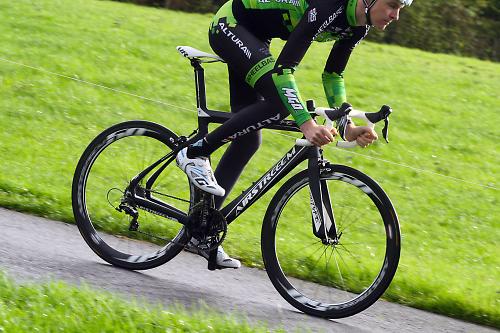
Descending on the Aerotype was a whole heap of fun due the combined front end stiffness and fast-handling geometry. If you've got the confidence to chuck it into corners aggressively, then it rewards you with an instant steering response and a bucket load of g forces.
This characteristic means it's perhaps not the best for more cautious descenders who require something more stable, which will hold a line well through any corner.

In spite of the deep tube profiles and stout looking stays, the Aerotype isn't uncomfortable in the slightest. The ride is surprisingly smooth really, and getting in the miles on typical UK roads wasn't an issue at all.
For 2014, the Aerotype is reverting back to a non-integrated, but still aerodynamically profiled, seatpost which shouldn't radically the ride quality too much. If anything, it's likely to add a touch more compliance to the ride, depending on the design used of course.

The move to a standard seatpost is a welcome one, as the current integrated design is very limited in that it allows for zero height adjustment. The cap sits flush with the top of the cut so you'd better be sure that you're cutting in the right place.
To its credit, the clamp does allow for two effective seat post angles (73 degree standard and a 78 degree option for a TT position), but the lack of height adjustment is a real deal breaker in my book.

Airstreeem are at pains to promote their in-house R&D department which suggests that the Aerotype isn't just another re-badged generic frame from the Far East. This comes with an expectation that the quality control is going to be top-notch to justify the comparatively premium prices.
Disappointingly, the test bike had what appeared to be a small fold on the top tube, though whether this was actually a wrinkle in the carbon layup or simply a bit of excess paint, is unclear. In any case, it's unsightly and definitely not expected of a bike at this price.
At £1,749 for the frame, the Aerotype is competing against much more established brands whose reputations have been built over many years.

As well as the frame-only option, the Aerotype is available with a number of Shimano build kits. These range from the entry level 105 build at £2299.99, to the range topping Dura Ace Di2 at £4799.99 (see below for all the build options).
The test bike featured Shimano's recently introduced Dura Ace 9000 mechanical groupset with a couple of substitutions for the brakes and chainset. This option will put you back £3499.99.
Airstreeem are based on a direct distribution model so you won't find any down at your local bike shop.
Though this review is principally about the Aerotype frame, the superlative performance of the Dura Ace components is worth a mention.
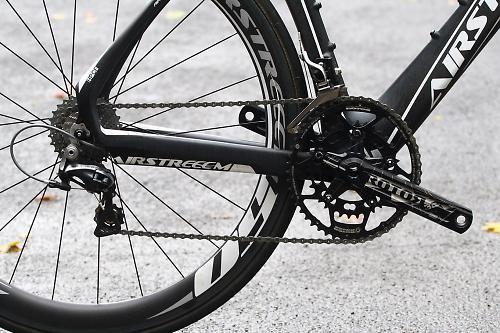
In short, I was extremely impressed. The shifting smoothness has been increased another notch, with consistent feel across the cassette and a much lighter action at the front.
The hoods themselves have been slimmed down significantly and are now much closer in shape to their electronic counterparts. Even with my relatively large hands, this change made a massive different to comfort – they were easily the most comfortable hoods I have every used.

For those on a smaller budget, the recently released Ultegra 6800 looks to have integrated a lot of the positives of the new Dura Ace, including the revised ergonomics and shifting feel, making it a very attractive proposition indeed.
The Airstreeem badged brakes are more of a disappointment however, especially as the new Dura-Ace 9000 brakes have been universally acclaimed.

I found that they were a bit 'sticky' and the quick releases were very stiff and, basically, didn't work.
The test bike was actually the Airstreeem marketing guy's own personal bike so perhaps they just needed a bit of looking after, but not speccing the Shimano brakes as standard is a negative point.
The other substitution comes in the form of Rotor cranks and Q rings - an interesting choice.

It was my first experience on the ovalised chainrings and I have to say that I didn't notice that much of a difference.
The sensation was of a slightly quicker transition through the dead sport, but it wasn't like I was putting out 10 extra watts or anything.
In any case, it shouldn't be too hard to sell the rings if they are not your thing.

The test bike came equipped with Airstreeem's own Aero 50 Superlight carbon tubular wheels which are a £1200 upgrade over the standard spec options, which include a set of Airstreeem AL30s – a mid-section aluminium clincher wheel.
At 50mm deep and weighing a claimed 1220g you appear to be getting quite a lot of wheel for your money, provided you fall under the 100kg rider weight limit.

With an outer rim width 24.5mm, the Aero 50s are also bang on trend with all the latest offerings from the big manufacturers, and should in theory provide a bit more stability in cross winds.
Out on the road, the Aero 50s are indeed super quick to spin up to speed and reinforce the Aerotype's playful handling. Unfortunately, their low weight has come at the expense of some stiffness as I experienced quite a bit of brake rub when out of the saddle.
For more powerful riders, the standard Aero 50 wheelset is said to be stiffer but they come with a weight penalty of 110 grams. Both wheelsets use 20/24 Sapim CX Ray spokes so presumably the spoke tensions are higher to achieve that improved stiffness.

In a straight line, they do seem to hold their speed well, though not as well as the Reynold's Aero 50s I tested back in summer, going by my power meter data anyway.
More noticeable is the comparatively poor performance whenever the wind starts to come over your shoulder. Though they're not impossible to handle in high winds, you'd definitely think twice before taking them out when the weather people were predicting anything over 20mph, whereas the Reynolds were just fit and forget.
That said, the Reynolds are £900 more, so you'd expect some sort of compromise somewhere.

More worrying is the fact that I suffered a complete freehub failure approximately two weeks into the four week test period. It happened on the first cold morning we've had this winter down here in the West Country, and also coincided with me having cleaned the cassette with it on the wheel the day before.
All three pawls just failed to engage and I had to rely on a friend's helping hand to push me back home.
Closer inspection revealed that the hubs use just a single circular spring to actuate the pawls. A lack of grease and a bit of dirt caused just enough resistance at the pawl hinges that the spring couldn't pull them into their upright position in order to engage with the freehub.
After a bit of a clean-up and a liberal application of grease I was back on my way, and the hubs have continued to function without issue since then.
Airstreeem are apparently changing the freehub design to use individual springs for each pawl – a more reliable design which is employed by most other hubs.
The failure still leaves a bit of a sore taste in the mouth though and I'd be wary of recommending the wheels until the durability of their new design is proven.
On a more positive note, I found the braking to be about as good as can be expected from a carbon rim. The feel is definitely more progressive than aluminium, but still entirely predictable once you've got used to them. Wet or dry, I was always confident in what I'd expect when I pulled on the levers.
Verdict
The Aerotype delivers an exciting and razor sharp ride that will reward any rider with the confidence to throw it around. It's not cheap however, and its general practicality is severely limited by the integrated seat post design.
road.cc test report
Make and model: Airstreeem Aerotype
Size tested: 56
About the bike
State the frame and fork material and method of construction. List the components used to build up the bike.
Carbon frame and fork. The following Shimano build kits are available:
105 - AL30 Wheels - £2299.99
Ultegra 11s/Rotor 3D crank - AL30 Wheels - £2999.99
Dura Ace 11s/Rotor 3D crank - Al30 Wheels - £3499.99
Ultegra Di2 11s/Rotor 3D crank - AL30 Wheels - £3699.99
Dura Ace Di2 11s/Rotor 3D crank - AL30 Wheels - £4799.99
Tell us what the bike is for, and who it's aimed at. What do the manufacturers say about it? How does that compare to your own feelings about the bike?
The bike is primarily aimed at riders who prioritize aerodynamics over weight. The flippable seat clamp ensures that you can achieve an efficient riding position if using the Aerotype with TT bars.
Frame and fork
Overall rating for frame and fork
7/10
Tell us about the build quality and finish of the frame and fork?
A small fold was present on the top tube which could have been due to a wrinkle in the layup or perhaps just a bit of excess paint. Either way, it was not what you would expect on a premium frame. Otherwise, the built quality looked satisfactory though it is difficult to tell with carbon frames.
Tell us about the materials used in the frame and fork?
The frame is constructed from "1K" carbon fibre. The fork is also carbon fibre including the steerer tube.
Tell us about the geometry of the frame and fork?
The frame sizes up very short for a given size and most riders will need to increase their stem length if using traditional drop handlebars.
How was the bike in terms of height and reach? How did it compare to other bikes of the same stated size?
Longer stem required to achieve my standard reach.
Riding the bike
Was the bike comfortable to ride? Tell us how you felt about the ride quality.
Surprisingly so. The bike was smooth over mildly rough roads.
Did the bike feel stiff in the right places? Did any part of the bike feel too stiff or too flexible?
The front triangle was rock solid despite the lack of seriously oversized tubes.
How did the bike transfer power? Did it feel efficient?
Again, the bike was rock solid under power.
Was there any toe-clip overlap with the front wheel? If so, was it a problem?
Yes. The short front centre of the bike means that many riders will find they have toe overlap. However, I only ever found it be a problem at junctions.
How would you describe the steering? Was it lively, neutral or unresponsive? Fast.
Tell us some more about the handling. How did the bike feel overall? Did it do particular things well or badly?
The handling was very direct and exciting. If you have the confidence to ride it aggressively, then the Aerotype was a blast to ride. The drawback to the lively ride was that it was quite difficult to ride no handed.
Which components had the most effect (good or bad) on the bike's comfort? would you recommend any changes?
The Conti tubs would have smoothed the ride out, but the frame must take some credit here.
Which components had the most effect (good or bad) on the bike's stiffness? would you recommend any changes?
A stiff stem is a must as the length required will tend to add flex.
Which components had the most effect (good or bad) on the bike's efficiency? would you recommend any changes?
The 50mm deep wheels certainly kept the speed up.
Rate the bike for efficiency of power transfer:
8/10
Rate the bike for acceleration:
8/10
Rate the bike for sprinting:
8/10
Rate the bike for high speed stability:
6/10
Rate the bike for cruising speed stability:
6/10
Rate the bike for low speed stability:
7/10
Rate the bike for flat cornering:
8/10
Rate the bike for cornering on descents:
9/10
Rate the bike for climbing:
8/10
The drivetrain
Rate the drivetrain for performance:
9/10
Excellent Dura Ace groupset
Rate the drivetrain for durability:
6/10
Not enough time to truly test this.
Rate the drivetrain for weight:
8/10
Rate the drivetrain for value:
7/10
Ultegra looks to be your best bet if value is a priority.
Wheels and tyres
Rate the wheels and tyres for performance:
8/10
Good wheels, but still not comparable to more expensive options.
Rate the wheels and tyres for durability:
7/10
The tubs suffered a number of large cuts but did not puncture.
Rate the wheels and tyres for weight:
8/10
100kg weight limit on the wheels.
Rate the wheels and tyres for comfort:
8/10
Rate the wheels and tyres for value:
8/10
Controls
Rate the controls for performance:
9/10
Rate the controls for durability:
8/10
Rate the controls for weight:
8/10
Rate the controls for comfort:
8/10
Rate the controls for value:
7/10
Your summary
Did you enjoy riding the bike? Yes.
Would you consider buying the bike? Only the 2014 model with the standard seatpost.
Would you recommend the bike to a friend? Yes, but see above.
Rate the bike overall for performance:
7/10
Rate the bike overall for value:
6/10
About the tester
Age: 22 Height: 190cm Weight: 69kg
I usually ride: Canondale EVO Red My best bike is:
I've been riding for: Under 5 years I ride: Every day I would class myself as: Semi pro
I regularly do the following types of riding: road racing, time trialling, cyclo cross, commuting, mtb,
For 5 years, racing was my life and I went all the way from a newbie bonking after 40 miles, to a full-timer plying my trade on the Belgian kermesse scene. Unfortunately, the pro dream wasn't meant to be and these days, you're more likely to find me bimbling about country lanes and sleeping in a bush on the side of the road.
Latest Comments
- mdavidford 1 sec ago
You seem to have bought into this misleading quote:...
- Smac9 14 min 27 sec ago
I think the 2.5 star rating is a bit mean . I own one of these and have no issues using them. I am not a chemical engineer so cannot verify the eco...
- David9694 13 min 44 sec ago
Hi all I'm looking for advice on what constitutes vigilantism (and what doesn't) and whether you get called "pedo" etc if you practise it. ...
- David9694 38 min 1 sec ago
Faussett Hill, Canterbury, reopens after car crashes into fence belonging to The Granville pub...
- AidanR 56 min 38 sec ago
That's my thinking too. Why would I be concerned about my visibility by night, but not by day?
- Rome73 59 min 17 sec ago
No, Lime pay the councils to operate in the borough, not the other way around. They will also pay for the infrastructure - how much will depend on...
- dh700 2 hours 21 min ago
If you believe the Dutch have solved this problem via construction, explain why their cyclist fatality rate remains so disturbingly high. They are...
- Rendel Harris 2 hours 46 min ago
The compulsory third-party insurance in NZ only covers personal injury; property damage requires extra insurance that isn't compulsory, so that's...
- andystow 4 hours 6 min ago
This is the bike I used for my LEJoG last year. After that, it deserved a treat: new powder coat and new wheels after the Hunt wheels cracked at...




































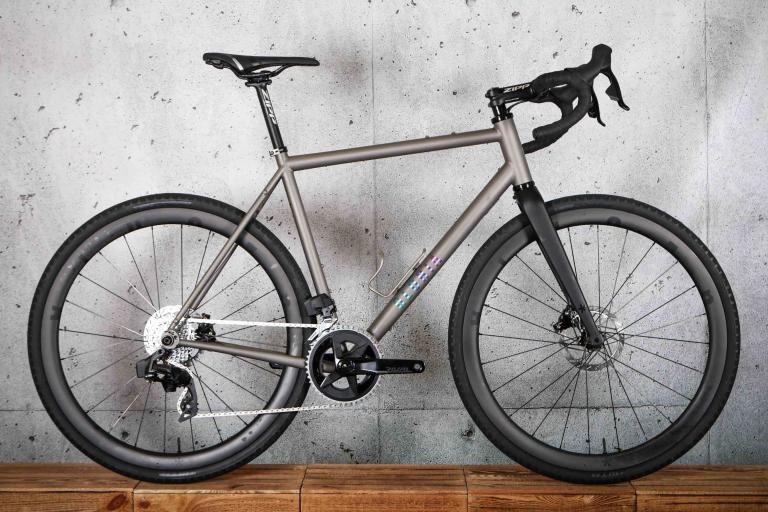
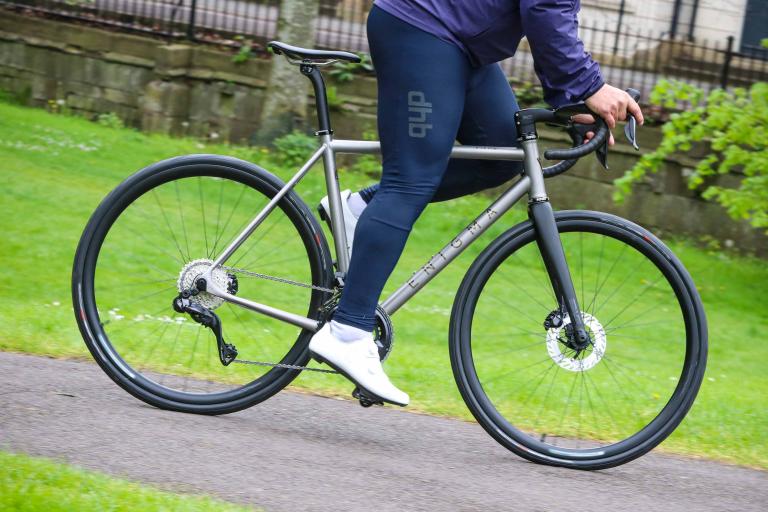
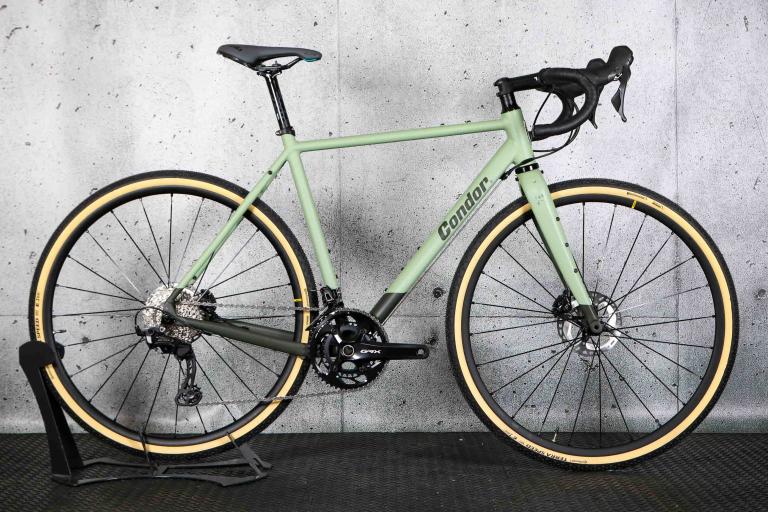
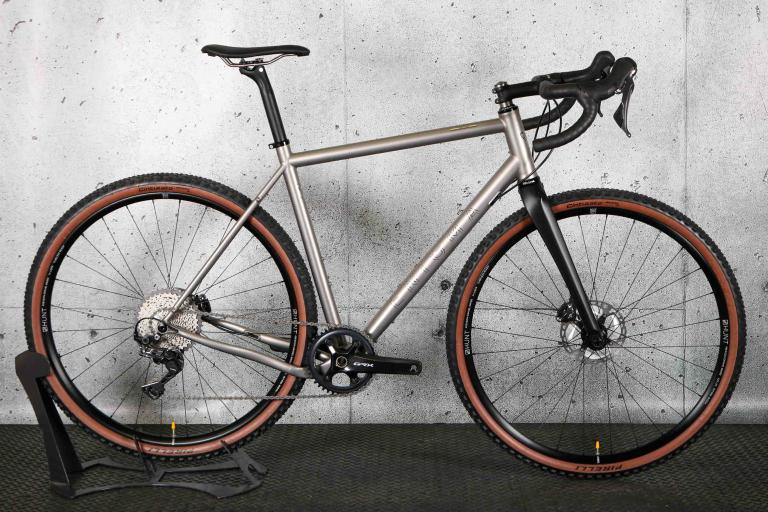
Add new comment
2 comments
Speaking of direct-sales aero bikes, when can we expect to hear more about Rose's effort?
It looks quite scary with the saddle set up so far out of the recommended range.
Is it because it's so hard to set it up properly or was it your idea to install it this way?